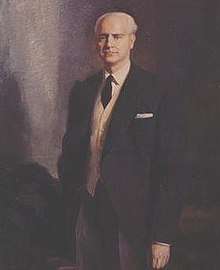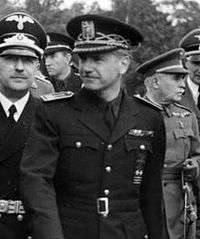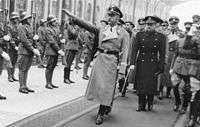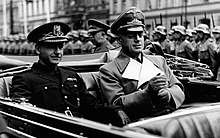Ramón Serrano Suñer
| The Most Excellent Ramón Serrano Suñer OSL | |
|---|---|
 | |
| Minister of the Interior | |
|
In office 30 January 1938 – 16 October 1940 | |
| Succeeded by | Valentín Galarza Morante |
| Minister of Foreign Affairs | |
|
In office 16 October 1940 – 3 September 1942 | |
| Succeeded by | Francisco Gómez |
| Personal details | |
| Born |
Ramón Serrano Suñer 12 September 1901 Cartagena, Spain |
| Died |
1 September 2003 (aged 101) Madrid, Spain |
| Nationality | Spanish |
| Political party | FET y de las JONS |
| Spouse(s) | Ramona (Zita) Polo y Martínez-Valdés |
| Relations | Francisco Franco (brother-in-law) |
| Children |
Fernando Francisco Jaime José María Ramón |
| Alma mater | Complutense University |
| Signature |
|
| Nickname(s) | Cuñadísimo |
Ramón Serrano Suñer (12 September 1901 – 1 September 2003), was a Spanish politician during the first stages of General Francisco Franco's Spanish State, between 1938 and 1942, when he held the posts of President of the Spanish Falange caucus (1936), and then Interior Minister and Foreign Affairs Minister. Serrano Suñer was known for his pro-Third Reich stance during World War II, when he supported the sending of the Blue Division to fight along with the Wehrmacht on the Russian front.[1] He was also the brother-in-law of the Spanish caudillo General Franco, for which he was nicknamed Cuñadísimo. (Franco himself was, officially, the generalísimo.)
Serrano Suñer was the founder of the 67,000-strong Spanish blind people's organization ONCE on 13 December 1938, as well as of the EFE press-agency, in 1939. Serrano Suñer also founded the Radio Intercontinental radio network in 1950.
Early life
He was born Ramón Serrano Suñer in Cartagena, the fifth of seven children born to an engineer working in the Valencian port of Castellón de la Plana. Although he was an excellent student, his father disapproved of his plans to become a lawyer. He enrolled at the Madrid University to study law, just the same. A fellow student was José Antonio Primo de Rivera (son of Spanish dictator Miguel Primo de Rivera, and founder of the Falange). He also spent a year in Bologna, during which he developed a taste for fascism.
Ramón Serrano Suñer and Francisco Franco were co-brothers-in-law, since the two married two sisters: Serrano Suñer married Ramona (Zita) Polo y Martínez-Valdés, in Oviedo on 6 February 1932, whom he had met shortly after moving to Zaragoza in 1931. Franco married Carmen Polo y Martínez-Valdés in October 1923. Ramón Serrano Suñer and Zita Polo had six children: Fernando, Francisco, Jaime Javier, José, María del Pilar and Ramón Serrano-Suñer y Polo.[2]
Carmen Díez de Rivera e Icaza was Ramón Serrano Suñer's illegitimate daughter with the Marquis of Llanzol's wife but he never recognized it. Not knowing they were half-siblings, Carmen and Ramón Serrano Suñer y Polo fell in love and were only prevented from marrying at the last minute. Disenchanted, she later became a leftist politician and member of the European Parliament.[3] Carmen, a most beautiful woman in her youth, with blue "aryan" eyes, like Serrano's, was highly educated and fluent in several languages. She became the Personal Secretary of Adolfo Suarez, the first Spanish Prime Minister to be democratically elected after Franco's death.
Political career
Suñer was a member of the Cortes within the group of the right-wing CEDA (although he would not get to formally adscribe to the CEDA).[4] Prior to the Spanish Civil War he distanced himself from the CEDA and approached the fascist Falange Española de las JONS; although he would not join them either, he called the members of the youth wing group JAP to flee to the Falange already in the Spring of 1936.[5] After the military coup of July 1936 and the outbreak of the Civil War, he was locked in a Republican prison. He escaped in October 1936, dressed as a woman, and was then helped by the Argentine navy in getting to France, from where he was able to reach Salamanca, on 20 February 1937, where Franco was in office at the time. It was there that he could work with Franco to participate in the rebellious side of the Spanish Civil War.
In 1938 Serrano Suñer went to Nuremberg with Nicolás Franco, brother of his brother-in-law, General Francisco Franco, probably to the 10th Nuremberg Rally (Reichsparteitag Grossdeutschland in German) of the Nazi Party, to celebrate the previous Austrian Anschluss, March 1938.
Serrano Suñer served as Nationalist Minister of the Interior (1 February 1938 – 9 August 1939). When Franco amalgamated that Ministry with the Ministry of Public Order, "Ministerio de Orden Público" in Spanish, a new name was created, "Ministerio de la Gobernación", but usually that new name is translated nowadays as "Ministry of the Interior". This amalgamation was made by Franco on 9 August 1939, whereby Serrano Suñer became "Ministro de la Gobernación" on 9 August 1939.

Suñer also managed to re-elaborate the statutes of the Falange Española Tradicionalista y de las JONS, decreasing the political power of the Secretary General in favour of a newly created office, the President of the Political Council, on which he was appointed in 9 August 1936.[6] He felt the office of Gobernación in 16 October 1940. It was just the day before, 15 October 1940, that the former President of the Generalitat of Catalonia, Lluis Companys was executed by a firing squad at Barcelona. On 13 August, Companys had been handed back by the Gestapo authorities of occupied Paris to head-hunter Spanish policeman and spy Pedro Urraca Rendueles, along with the extradition of Basque Minister of the Interior Julián Zugazagoitia who served under Republican Prime Minister Juan Negrín.
While Serrano Suñer had been Minister of the Interior, the Minister of Foreign Affairs was General Juan Luis Beigbeder y Atienza, formerly a Military Attaché at the Spanish Embassy Berlin as an Army Commandant in 1926. Already as a Colonel, he was the predecessor of Serrano Suñer as a Spanish Minister of Foreign Affairs.
In September 1940, the strongly pro-Axis Serrano Suñer visited Berlin to meet the German Foreign Minister Joachim von Ribbentrop to discuss how Spain might best enter the war on the Axis side.[7] During the meeting, Serrano Suñer presented a "shopping list" to Ribbentrop, saying Spain wanted Gibraltar from the British; all of French Morocco and Algeria "which belonged to Spain's Lebensraum" ; and about Portugal, he said: "Geographically speaking, Portugal has no right to exist".[7] Additionally, Serrano Suñer wanted generous promises of German military and economic support before Spain entered the war.[7] Serrano Suñer and Ribbentrop did not get along and the two men soon developed an intense mutual hatred of one another.[7] Ribbentrop told Serrano Suñer that in return for military and economic aid and allowing the return of Gibraltar, the Reich wanted to annex at a minimum one of the Canary islands (through Ribbentrop stated that he preferred that Germany have all of the Canaries, but he was prepared to be magnanimous by taking only one); that Germany be allowed air and naval bases in Spanish Morocco with extraterritorial rights; German companies to be given control of the mines in Spanish Morocco; and finally Ribbentrop wanted an economic treaty that would have turned Spain into an economic colony of Germany.[7] For the pro-Axis Serrano Suñer who had been expecting the Germans to treat Spain as an ally and equal, to learn that the Germans viewed Spain as little more than a satellite state was a great shock.[7] During his visits to Berlin, Serrano Suñer, who had started to rethink the wisdom of Spain entering the war, was overruled by General Franco, who was keen to enter the war as soon as possible on the Axis side before Britain was defeated.[7] Franco in his letters to Serrano Suñer praised Hitler as a wise statesman and dismissed Ribbentrop's demands as the product of a man who failed to properly appreciate what Spain had to offer the Axis.[8]

Meanwhile, even on becoming Minister of Foreign Affairs, Serrano Suñer had to accept Jacobo Fitz-James Stuart y Falcó, 17th Duke of Alba, as Ambassador to London, who since November 1937 represented rebellious Franco and since March 1939 represented Francisco Franco until March 1945. The 17th Duke of Alba had been formerly a Minister of Public Instruction, later Minister of State, 1930–1931, under the dictatorship of General Dámaso Berenguer.
In June 1939 Serrano Suñer had been back to Italy to present Benito Mussolini with the thousands of repatriated Italian soldiers who had fought by the side of Franco in Spain against the Spanish Republican soldiers. He was appointed the 263rd Minister of Foreign Affairs (18 October 1940 – 3 September 1942), thanks to his skill at building a relationship with Benito Mussolini.
Even though he was working alongside Franco, he objected to the increasing role of the Catholic Church in Falangist politics. The two brothers-in-law had some intra-party conflicts of their own, as Serrano Suñer accused Franco of riding on a "cult of personality," while Franco viewed Serrano Suñer as increasingly becoming a thorn in the side of his party, criticizing too many of its policies.
Involvement in World War II
Just one week after Serrano Suñer was promoted to Minister of Foreign Affairs, on 23 October 1940, Francisco Franco and Adolf Hitler met at the Hendaye railway station in France, near the Spanish border. There, Serrano Suñer met German Foreign Affairs Minister Joachim von Ribbentrop. Paul Schmidt, head interpreter of the German Chancellor, reported that Franco sat between Joachim von Ribbentrop and Walther von Brauchitsch, while Adolf Hitler sat between the Spanish Foreign Affairs Minister Ramón Serrano Suñer and the Spanish Ambassador at Berlin, Eugenio Espinosa de los Monteros. However, neither the Spanish Ambassador at Berlin nor the German Ambassador at Madrid, Eberhard von Stohrer, were allowed at the exhaustive and inconclusive political meetings. By morning the meeting ended with no compromise. Serrano Suñer was later to say of the Hendaye summit that because of General Franco's obsession with Morocco, that if only Hitler had offered him French Morocco, then Spain would have entered the war in October 1940.[9]

Although Serrano Suñer had played a major role in establishing the Spanish state under Franco, being so influential as to be nicknamed the "Cuñadísimo", which translates as supreme brother-in-law (a joke on "Generalísimo"), and despite Serrano Suñer's advocating for Spain to join the Axis powers, Franco opted for Spain to remain a nonbelligerent during World War II. Serrano Suñer's protege Pedro Gamero del Castillo consulted in January 1941 with Hans Lazar, the press secretary of the German Embassy and told him that a Serrano Suñer government would commit to the Axis powers and thus asked for him to arrange for the Nazis to publicly back his mentor.[10] However it is unclear whether Gamero was working on his own initiative and Hitler was disappointed that Serrano Suñer had not tried harder to help Germany, and called him the "gravedigger of the new Spain".
To make up for this failure, Serrano Suñer proposed the Blue Division of Spanish volunteers[11] to fight with the Germans against the Soviet Union and communism after Operation Barbarossa, 22 June 1941.
On 25 November 1941 he signed in Berlin the revision of the pact of 25 November 1936 Germany–Japan Anti-Komintern Pact, an Anti-Communist pact concluded between Nazi Germany and the Empire of Japan (later to be joined by other countries) directed against the Communist International (Comintern) or Komintern.
In September 1942, following the Basilica of Begoña incident of August 1942, Serrano Suñer was forced to resign as foreign minister and president of the political council of the Falange Española Tradicionalista y de las JONS.[12] However, a full understanding of his dismissal also requires to consider personal and family issues.[13] After World War II, he wrote a persuasive letter to Franco, calling for a transitional government that would have room for intellectuals in exile. When Franco received the letter, he wrote a derisive "Ho-ho." in its margin. Serrano Suñer ultimately retired from public life in 1947, but lived longer than most of the people he worked with. Serrano Suñer died on 1 September 2003 in Madrid, eleven days before his 102nd birthday.[14]
References
- ↑ "La Etapa de Ramón Serrano Súñer en el Ministerio de Asuntos Exteriores". Archived from the original on 2 October 2011. Retrieved 2 October 2011.
- ↑ Ramón Serrano Suñer (in Spanish)
- ↑ María Luisa Mataix, "Carmen Díez de Rivera e Icaza". A short biography in Spanish (December 2002), based on Ana Romero, Historia de Carmen. Memoria de Carmen Díez de Rivera, Editorial Planeta.
- ↑ Redondo 1993, p. 201.
- ↑ Lowe 2010, p. 221.
- ↑ Gil Pecharromán 2013, p. 43.
- 1 2 3 4 5 6 7 Preston, Paul "Franco and Hitler: The Myth of Hendaye 1940" pages 1-16 from Contemporary European History, Volume 1, Issue # 1, March 1992 page 5.
- ↑ Preston, Paul "Franco and Hitler: The Myth of Hendaye 1940" pages 1-16 from Contemporary European History, Volume 1, Issue # 1, March 1992 page 6.
- ↑ Preston, Paul "Franco and Hitler: The Myth of Hendaye 1940" pages 1-16 from Contemporary European History, Volume 1, Issue # 1, March 1992 page 14.
- ↑ Paul Preston, Franco, London: 1995, p. 415
- ↑ 250. Infanterie-Division
- ↑ Ellwood 1987, p. 74; Marquina Barrio 1989, p. 167.
- ↑ Nieves Herrero, Lo que escondían sus ojos, La esfera de los Libros, Barcelona: 2013
- ↑ "Ramón Serrano Suner, 101, a Franco Aide". The New York Times. 4 September 2003. Retrieved 4 September 2003.
Bibliography
- Ellwood, Sheelagh (1987). "Las fuentes orales y la historiografía del fascismo español" (PDF). Revista de Historia Jerónimo Zurita. 56: 65–79. ISSN 0044-5517.
- Gil Pecharromán, Julio (2013). El Movimiento Nacional (1937-1977). Barcelona: Grupo Planeta. ISBN 978-84-08-12138-1.
- Lowe, Sid (2010). Catholicism, War and the Foundation of Francoism: The Juventud de Acción Popular in Spain, 1931-1939. Sussex Academic Press. ISBN 978-1-84519-373-7.
- Marquina Barrio, Antonio (1989). "La Etapa de Ramón Serrano Súñer en el Ministerio de Asuntos Exteriores" (PDF). Espacio, Tiempo y Forma, Serie V, Historia Contemporánea. Universidad Nacional de Educación a Distancia (2): 145–167.
- Redondo, Gonzalo (1993). Historia de la Iglesia en España, 1931-1939: La Guerra Civil, 1936-1939. Ediciones Rialp. ISBN 84-321-3016-8.
External links
- Cien Empresarios Españoles del Siglo Veinte Info on a book, 672 pages, by Rojo Cagigal, Juan Carlos . Azagra Ros, Joaquín Pedro . Arana Pérez, Ignacio . Echániz Ortúñez, José and others, 13 economists in total . ISBN 978-84-88717-27-6, 2000. (in Spanish)
- Milicia y diplomacia: los diarios del Conde de Jordana 1936-1944, forewords and initial study by Carlos Seco Serrano. (Selección y glosas de Rafael Gómez- Jordana Prats). Burgos: Dossoles, 2002. "Colección La Valija Diplomática". 311 pp. ISBN 9788487528453. (in Spanish)
- Charles B. Burdick. Germany's Military strategy and Spain In World War II.Syracuse Univ. Press, Syracuse, U.S.A., (1968). 228 pages. ISBN 978-0-608-18105-9. Former American Professor Charles B. Burdick biography can be seen at:
- Madrid Carmen Díez de Rivera
- Memorias de Carmen Diez de Rivera
- Ramón Serrano Súñer, Entre Hendaya y Gibraltar. ISBN 978-84-08-10417-9, (2011).
- Pauley, Bruce F. (1981). Hitler and the Forgotten Nazis: A History of Austrian National Socialism, University of North Carolina Press. ISBN 0-8078-1456-3.
- El general Beigbeder
- Tánger y otras utopías
- Cuando Tánger era internacional: la ciudad, su historia y sus gentes
- Rosalinda Powell fox, daughter of the Raj and Spain
- Rosalinda, la aventurera de entreguerras
- Gobiernos de España 1931-2008
| Wikimedia Commons has media related to Ramón Serrano Súñer. |
- Ramón Serrano Suñer in Dialnet
- Necrology in ABC.es
- British Diplomacy and the fall of Serrano Suñer
- «Perspectiva actual de Ramón Serrano Suñer» by José María Laso
- Serrano Suñer and the Memoria Histórica
- Serrano Suñer and Francoist Repression
- José Antonio viewed by Ramón Serrano Suñer—Fundación Francisco Franco
- «Serrano Suñer. Dos velocidades» by Aquilino Duque
- Foro Fundación Ramón Serrano Suñer
- Newspaper clippings about Ramón Serrano Suñer in the 20th Century Press Archives of the German National Library of Economics (ZBW)